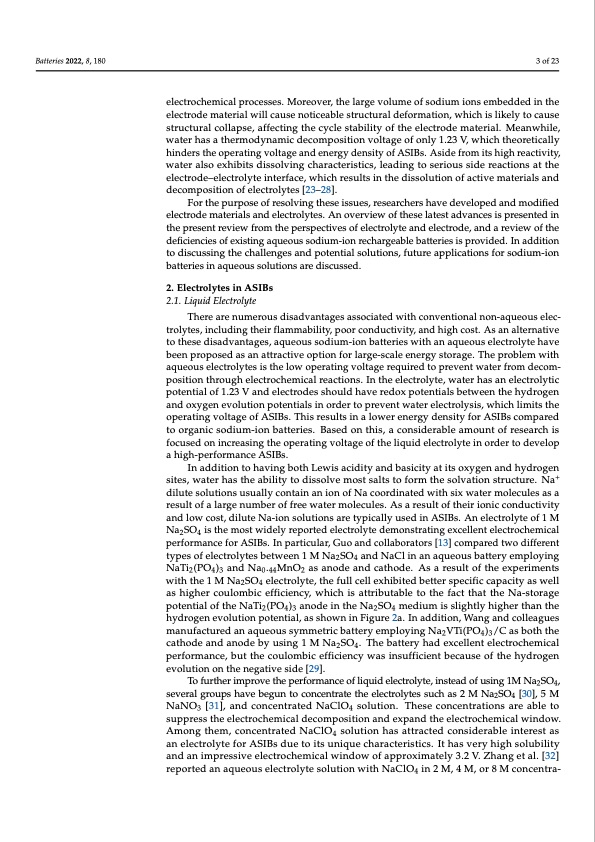
PDF Publication Title:
Text from PDF Page: 003
Batteries 2022, 8, 180 3 of 23 electrochemical processes. Moreover, the large volume of sodium ions embedded in the electrode material will cause noticeable structural deformation, which is likely to cause structural collapse, affecting the cycle stability of the electrode material. Meanwhile, water has a thermodynamic decomposition voltage of only 1.23 V, which theoretically hinders the operating voltage and energy density of ASIBs. Aside from its high reactivity, water also exhibits dissolving characteristics, leading to serious side reactions at the electrode–electrolyte interface, which results in the dissolution of active materials and decomposition of electrolytes [23–28]. For the purpose of resolving these issues, researchers have developed and modified electrode materials and electrolytes. An overview of these latest advances is presented in the present review from the perspectives of electrolyte and electrode, and a review of the deficiencies of existing aqueous sodium-ion rechargeable batteries is provided. In addition to discussing the challenges and potential solutions, future applications for sodium-ion batteries in aqueous solutions are discussed. 2. Electrolytes in ASIBs 2.1. Liquid Electrolyte There are numerous disadvantages associated with conventional non-aqueous elec- trolytes, including their flammability, poor conductivity, and high cost. As an alternative to these disadvantages, aqueous sodium-ion batteries with an aqueous electrolyte have been proposed as an attractive option for large-scale energy storage. The problem with aqueous electrolytes is the low operating voltage required to prevent water from decom- position through electrochemical reactions. In the electrolyte, water has an electrolytic potential of 1.23 V and electrodes should have redox potentials between the hydrogen and oxygen evolution potentials in order to prevent water electrolysis, which limits the operating voltage of ASIBs. This results in a lower energy density for ASIBs compared to organic sodium-ion batteries. Based on this, a considerable amount of research is focused on increasing the operating voltage of the liquid electrolyte in order to develop a high-performance ASIBs. In addition to having both Lewis acidity and basicity at its oxygen and hydrogen sites, water has the ability to dissolve most salts to form the solvation structure. Na+ dilute solutions usually contain an ion of Na coordinated with six water molecules as a result of a large number of free water molecules. As a result of their ionic conductivity and low cost, dilute Na-ion solutions are typically used in ASIBs. An electrolyte of 1 M Na2SO4 is the most widely reported electrolyte demonstrating excellent electrochemical performance for ASIBs. In particular, Guo and collaborators [13] compared two different types of electrolytes between 1 M Na2SO4 and NaCl in an aqueous battery employing NaTi2(PO4)3 and Na0.44MnO2 as anode and cathode. As a result of the experiments with the 1 M Na2SO4 electrolyte, the full cell exhibited better specific capacity as well as higher coulombic efficiency, which is attributable to the fact that the Na-storage potential of the NaTi2(PO4)3 anode in the Na2SO4 medium is slightly higher than the hydrogen evolution potential, as shown in Figure 2a. In addition, Wang and colleagues manufactured an aqueous symmetric battery employing Na2VTi(PO4)3/C as both the cathode and anode by using 1 M Na2SO4. The battery had excellent electrochemical performance, but the coulombic efficiency was insufficient because of the hydrogen evolution on the negative side [29]. To further improve the performance of liquid electrolyte, instead of using 1M Na2SO4, several groups have begun to concentrate the electrolytes such as 2 M Na2SO4 [30], 5 M NaNO3 [31], and concentrated NaClO4 solution. These concentrations are able to suppress the electrochemical decomposition and expand the electrochemical window. Among them, concentrated NaClO4 solution has attracted considerable interest as an electrolyte for ASIBs due to its unique characteristics. It has very high solubility and an impressive electrochemical window of approximately 3.2 V. Zhang et al. [32] reported an aqueous electrolyte solution with NaClO4 in 2 M, 4 M, or 8 M concentra-PDF Image | Aqueous Rechargeable Sodium-Ion Batteries Hydrogel

PDF Search Title:
Aqueous Rechargeable Sodium-Ion Batteries HydrogelOriginal File Name Searched:
batteries-08-00180-v2.pdfDIY PDF Search: Google It | Yahoo | Bing
Salgenx Redox Flow Battery Technology: Salt water flow battery technology with low cost and great energy density that can be used for power storage and thermal storage. Let us de-risk your production using our license. Our aqueous flow battery is less cost than Tesla Megapack and available faster. Redox flow battery. No membrane needed like with Vanadium, or Bromine. Salgenx flow battery
| CONTACT TEL: 608-238-6001 Email: greg@salgenx.com | RSS | AMP |